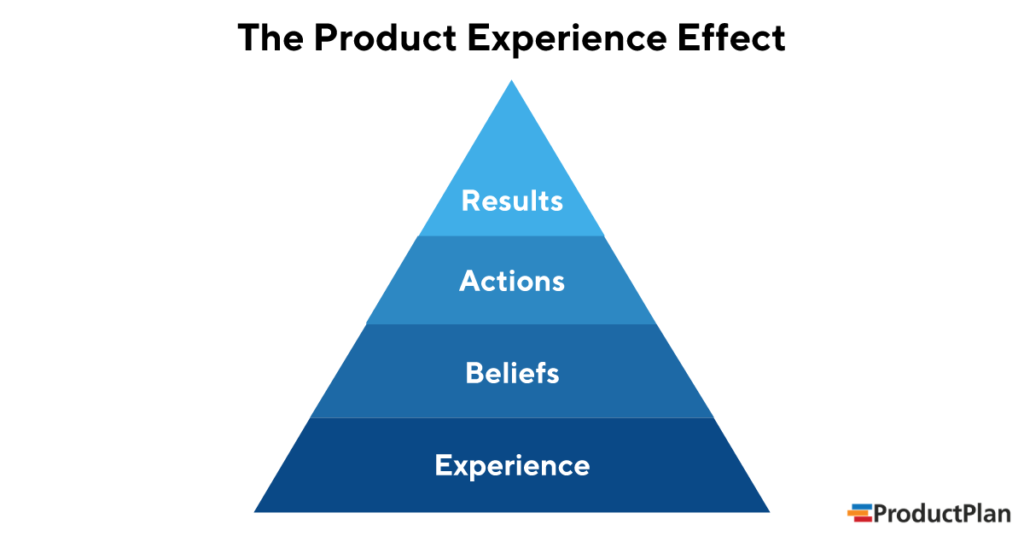A human mind is a pattern-seeking machine. Our species has evolved an impressive ability to spot small, subtle clues to more significant trends. In prehistoric times, this helped us find food sources and avoid predators’ hunting grounds. Today, your customers are using this same pattern-seeking skill to turn their product experiences into beliefs about your company and your products.
Even a few lousy product experiences can shake a customer’s trust. Therefore, it’s crucial for product managers, developers, and your entire cross-functional team to examine—and re-examine—the product experience from your user’s point of view and incorporate it into your product strategy.
For example, you should frequently ask questions about your product experience, such as:
- Is our product intuitive enough that users will be able to find their way around quickly?
- Are we putting the most essential features front-and-center, or at least in the most logical places in our app?
- Do we require users to take any unnecessary steps to complete their desired tasks?
- Is our onboarding process smooth and inviting?
- When we release new functionality, are we making sure all of our users know about it and how to use it?
What Happens to Your Customers After Bad Product Experiences
A bad product experience—even a minor inconvenience or missing piece of functionality—can have a terrible snowball effect on customers.
First, it can lead to users having negative beliefs about your product. Then, those negative beliefs could affect how customers use the product, which can then lead to customers getting poor results from it.

Every interaction with your product leads to a product experience—which your users mentally record, sometimes without realizing it, as good or bad, satisfying or unsatisfying.
For this reason, it’s particularly vital that you, the product development team, create the best possible experience when your product is new to the market and for each new user.
An Example of How a Product Experience Informs Brand Beliefs
To illustrate what I mean, let’s take the following hypothetical. We’ll see how failing to create an excellent product experience can cause this negative snowball effect.
Hypothetical Product: SaaS accounting app
Hypothetical Persona: Owner of a small or midsized accounting firm
User belief
“This new piece of accounting software will help my firm automate a lot of the tax return preparation for our clients. We’ll be able to process the average return much more quickly and efficiently. The time savings will let us take on more clients and lower our rates.”
Product experience
“My colleagues and I have found that the software has some useful functionality, but it’s missing key features we were hoping it had. Although we have shaved some time off of the average tax return, we are not experiencing anywhere near the time savings we had expected. If the app maker didn’t think to include these features already, we’re not confident they understand our industry.”
User actions
“Our company will continue to use this software for now, but we’ll have to perform those tasks we assumed the app would automate manually. I think we’ll begin looking for alternatives after tax season passes.”
Results
“This app didn’t free up the time we expected. Therefore, we can’t sign up any new clients, so we weren’t comfortable marketing our services this tax season. This app didn’t allow us to expand our business the way we’d hoped, and we are disappointed.”
Note: Your user’s results should be similar to how you pitched the product to that user in the first place. That means it should align closely to the user’s beliefs. But as you can see from this hypothetical, the results don’t match up at all with the beliefs this accounting firm held when they purchased the software.
A Product Experience Can Fail in Several Ways
As you might have noticed in the example above, I didn’t state that the makers of this hypothetical accounting software failed to include those features the firm’s owner was hoping for. Maybe they were all right there in the app—but hidden in sub-menus, the accountants never searched. Or perhaps those features were placed prominently in the app—but named confusingly, so the accountants didn’t realize they were looking right at them.
There are many ways a product experience can fail, and lacking key functionality is just one of them. You also need to be mindful of other pitfalls, like these:
- The product is buggy or slow.
- The app doesn’t present the most crucial functionality in the most prominent places.
- Your help file or onboarding tools don’t give quick and easy answers to new users’ questions.
- Your features’ names aren’t intuitive, or they don’t “speak the language” of your user’s industry.
- And yes, the product could be missing key features your users are counting on.
Always remember that even minor inconveniences in your product can cause your users frustration. That frustration can lead to negative beliefs about your products, which can turn those users against your entire company.
With that in mind, creating a positive product experience—down to the smallest details—should be a significant priority in your overall product strategy.
An Important Truth About Your Product Experience
I’ll leave you with one final thought that I hope will inform your product development strategy: The newer a user is to your product, the more damaging a bad experience will be.
For instance, Microsoft has proven itself capable of releasing and supporting stable software apps. So, if you discovered a bug in PowerPoint, you probably wouldn’t think, “Well, this Microsoft app isn’t going to make it.” Finding a bug or two wouldn’t shake your confidence in PowerPoint or in the company itself.
But imagine your company had just started using a new SaaS solution from a small startup. Your first experience with the app was complicated or painful. That startup hasn’t yet earned your trust and confidence. Therefore, even a few frustrating moments using the product could harden into negative beliefs about both the product the company itself.
With this in mind, as your team begins thinking through a new product strategy, you should prioritize questions like these:
- How can we quickly earn trust and credibility during a new user’s first session with our product?
- Have we left any holes in functionality that could hurt the overall product experience?
- Are we making this product as user-friendly as we can?
Keep questions like these top-of-mind in your product strategy sessions. You’ll be on your way to creating an outstanding product experience for your users. 




